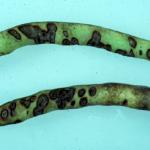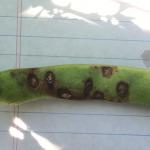Bean, Anthracnose
Colletotrichum lindemuthianum
Anthracnose of bean is distributed worldwide, but is more serious in temperate and subtropical zones. The pathogen causes one of the most important diseases of legume crops and yield losses can reach 100% when contaminated seeds are planted and environmental conditions remain favorable for disease development for long periods.
Identification:
The disease affects all aerial parts of the bean plant. Diseased cotyledons exhibit small, dark brown to black lesions. The developing hypocotyl can become infected, developing rust colored specks which enlarge longitudinally resulting in sunken lesions. Lesions are more common on leaf petioles, the lower surface of leaves, and leaf veins where they are elongate, angular, and brick-red to purple becoming black. Pod infections occur as tan to rust colored lesions that become sunker cankers with a raised black ring and brownish red border.
Life Cycle:
Bean anthracnose survives between crops in infected crop residue and can be disseminated in seeds, air, and water. Lesions begin producing fruiting bodies (acervuli) and conidia within 2-4 days of infection. Production of conidia and new plant infections are favored by temperatures of 13-26º C and relative humidity greater than 92 % (or free moisture). Frequent, moderate rainfall, particularly if accompanied by winds or splashing rain favor disease development.
Crop Injury:
Infected hypocotyls may rot and collapse, resulting in a poor stand. Severely affected pods may shrivel and dry. The fungus can invade the pods and infect the seed coat and cotyledons of developing seed.
Cultural Controls & Prevention:
- Start with certified, disease free seed. Production of pathogen-free seeds in dry areas has reduced disease incidence and severity.
- Certain cultivars of bean are resistant to anthracnose.
- Rotate with non-host crops such as cereals and corn, for 2-3 years.
- Promptly incorporate crop debris after harvest to hasten decomposition.
- Treat seed with appropriate fungicides to control seed coat infections.
- Preventive applications of fungicides have limited effectiveness.
Chemical Controls & Pesticides:
For Current information on disease recommendations in specific crops including information on chemical control & pesticide management, please visit the New England Vegetable Management Guide website.
Crops that are affected by this disease:
The Center for Agriculture, Food and the Environment and UMass Extension are equal opportunity providers and employers, United States Department of Agriculture cooperating. Contact your local Extension office for information on disability accommodations. Contact the State Center Director’s Office if you have concerns related to discrimination, 413-545-4800 or see ag.umass.edu/civil-rights-information.

